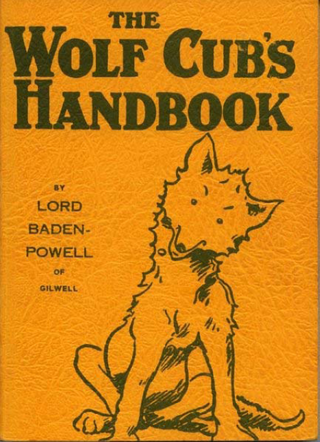
Scouting, also known as the Scout Movement, is a worldwide youth social movement employing the Scout method, a program of informal education with an emphasis on practical outdoor activities, including camping, woodcraft, aquatics, hiking, backpacking, and sports. Another widely recognized movement characteristic is the Scout uniform, by intent hiding all differences of social standing in a country and encouraging equality, with neckerchief and campaign hat or comparable headwear. Distinctive uniform insignia include the fleur-de-lis and the trefoil, as well as merit badges and other patches.

Ernest Thompson Seton was a Canadian-American author, wildlife artist, founder of the Woodcraft Indians in 1902, and one of the founding pioneers of the Boy Scouts of America (BSA) in 1910.

Scouting in Kentucky has a long history, from the 1910s to the present day, serving thousands of youth in programs that suit the environment in which they live. Kentucky has a very early Scouting heritage, as the home state of Daniel Carter Beard.

Camp Fire, formerly Camp Fire USA and originally Camp Fire Girls of America, is a co-ed youth development organization. Camp Fire was the first nonsectarian, multicultural organization for girls in America. It is now gender-inclusive, and its programs emphasize camping and other outdoor activities.

Cub Scouts, Cubs or Wolf Cubs are programmes associated with Scouting for young children usually between 8 and 12, depending on the organisation to which they belong. A participant in the programme is called a Cub. A group of Cubs is called a "Pack".

Daniel Carter "Uncle Dan" Beard was an American illustrator, author, youth leader, Georgist and social reformer who founded the Sons of Daniel Boone in 1905, which Beard later merged with the Boy Scouts of America (BSA).

Scout Life is the monthly magazine of the Boy Scouts of America (BSA). Its target readers are children between the ages of 6 and 18. The magazine‘s headquarters are in Irving, Texas.
The Sons of Daniel Boone, later the Boy Pioneers of America, was a youth program developed by Daniel Carter Beard in 1905 based on the American frontiersman. When Dan Beard joined the Boy Scouts of America (BSA) in 1910 as one of their national Scout commissioners, he merged his group into the fledgling BSA.

Edward Urner Goodman was an influential leader in the Boy Scouts of America (BSA) movement for much of the twentieth century. Goodman was the national program director from 1931 until 1951, during the organization's formative years of significant growth when the Cub Scouting and Exploring programs were established. He developed the BSA's national training center in the early 1930s and was responsible for publication of the widely read Boy Scout Handbook and other Scouting books, writing the Leaders Handbook used by Scout leaders in the United States during the 1930s and 1940s. In the 1950s, Goodman was Executive Director of Men's Work for the National Council of Churches in New York City and active in church work.

Scouts BSA Handbook is the official handbook of Scouts BSA, published by the Boy Scouts of America. It is a descendant publication of Baden-Powell's original handbook, Scouting for Boys, which has been the basis for Scout handbooks in many countries, with some variations to the text of the book depending on each country's codes and customs.

Captain Salt in Oz (1936) is the thirtieth book in the Oz series created by L. Frank Baum and his successors, and the sixteenth written by Ruth Plumly Thompson. It was illustrated by John R. Neill. The novel was followed by Handy Mandy in Oz (1937).

British Bulldog is a tag-based playground and sporting game, commonly played in schoolyards and on athletic fields in the UK, Canada, South Africa, Australia, and related Commonwealth countries, as well as in the U.S. and Ireland. The object of the game is for one player to attempt to intercept other players who are obliged to run from one designated area to another. British Bulldog is characterised by its physicality and is often regarded as violent, leading it to be banned from many schools due to injuries to the participants.

William Hillcourt, known within the Scouting movement as "Green Bar Bill", was an influential leader in the Boy Scouts of America (BSA) organization from 1927 to 1992. Hillcourt was a prolific writer and teacher in the areas of woodcraft, troop and patrol structure, and training; his written works include three editions of the BSA's official Boy Scout Handbook, with over 12.6 million copies printed, other Scouting-related books and numerous magazine articles. Hillcourt developed and promoted the American adaptation of the Wood Badge adult Scout leader training program.
Traditional Scouting is "old-fashioned" or "back to basics" Scouting in some form, often with an emphasis on woodcraft and scoutcraft activities. As a pluralist movement, there is no one set definition for the term, but most traditionalists share a common set of values and procedures. Traditionalists aim to return the Scout Movement to something approximating its original style and activities; rejecting the trend of modernizing the program in an attempt to widen its appeal and/or use the name "Scouts" for new programs for ever-younger children.

James Edward West was a lawyer and an advocate of children's rights, who became the first professional Executive Secretary, soon renamed Chief Scout Executive, of the Boy Scouts of America (BSA), serving from 1911 to 1943. Upon his retirement from the BSA, West was given the title of Chief Scout.

The Wolf Cub's Handbook is an instructional handbook on Wolf Cubs training, published in various editions since December 1916. Early editions were written and illustrated by Robert Baden-Powell with later editions being extensively rewritten by others. The book has a theme based on Rudyard Kipling's The Jungle Book jungle setting and characters.

The Boy Scouts of America (BSA) was inspired by and modeled on The Boy Scouts Association, established by Robert Baden-Powell in Britain in 1908. In the early 1900s, several youth organizations were active, and many became part of the BSA.

Scouting for Boys: A handbook for instruction in good citizenship is a book on Boy Scout training, published in various editions since 1908. Early editions were written and illustrated by Robert Baden-Powell with later editions being extensively rewritten by others. The book was originally a manual for self-instruction in observation, tracking and woodcraft skills as well as self-discipline and self-improvement, about the British Empire and duty as citizens with an eclectic mix of anecdotes and unabashed personal observations and recollections. It is pervaded by a degree of moral proselytizing and references to the author's own exploits. It is based on his boyhood experiences, his experience with the Mafeking Cadet Corps during the Second Boer War at the siege of Mafeking, and on his experimental camp on Brownsea Island, England.

The Every Boy's Library: Boy Scout Edition refers to a collection of 73 books that were published under the backing of the Boy Scouts of America. Every title was selected by the Scouts Library Commission, and were branded towards Scouts and included themes that would be of interest to young boys in the Scouting movement. These re-released many classic novels as well as newer works by those associated with the Scouting movement, include Ernest Thompson Seton and Daniel Carter Beard. This series of reprints was published by Grosset & Dunlap from November 1912 with reprints and editions lasting until the mid-1930s. Each edition includes a letter "To The Public" by then Chief Scout Executive James E. West. 30 original works were commissioned, as referenced by the original list in the back page of each edition.

















